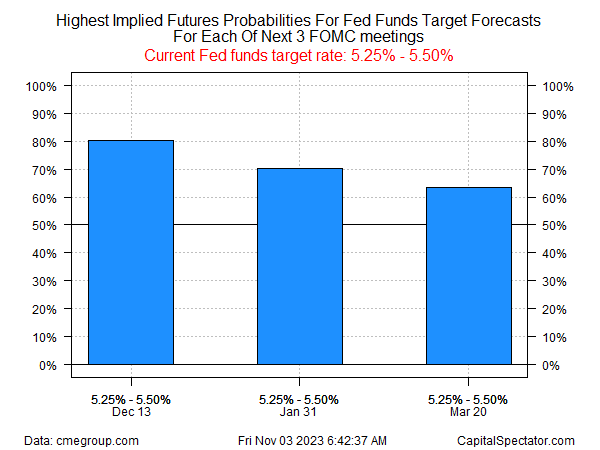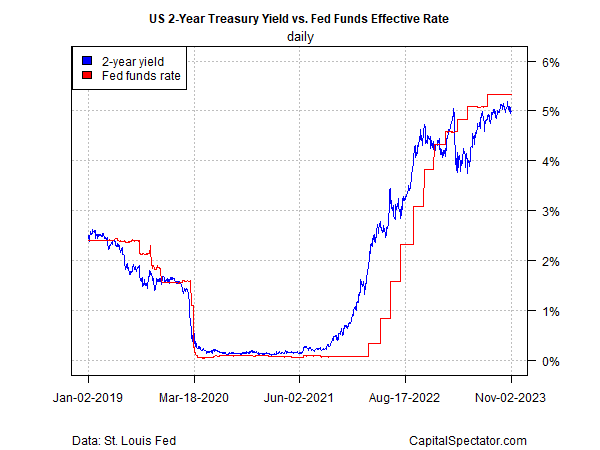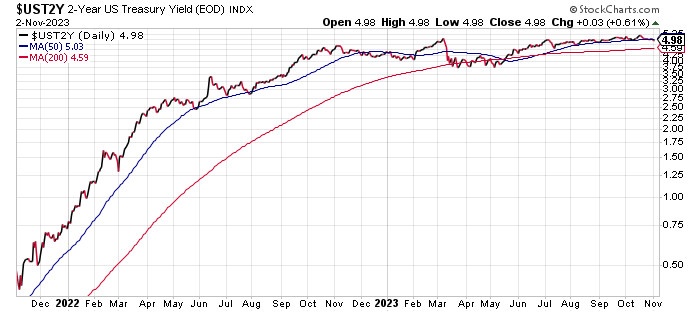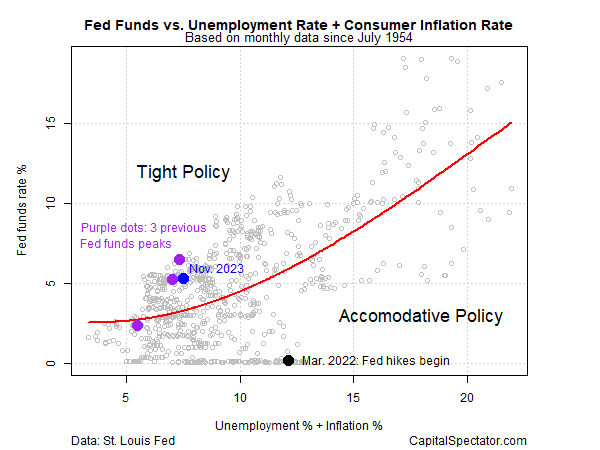Have Rates Peaked? Fed Comments, Treasury Yields Tell Different Stories
US2YT=X
0.27%
Add to/Remove from Watchlist
Add to Watchlist
Add Position
Position added successfully to:
Please name your holdings portfolio
Type:
BUY
SELL
Date:
Amount:
Price
Point Value:
Leverage:
1:1
1:10
1:25
1:50
1:100
1:200
1:400
1:500
1:1000
Commission:
Create New Watchlist
Create
Create a new holdings portfolio
Add
Create
+ Add another position
Close
US10Y…
+0.41%
Add to/Remove from Watchlist
Add to Watchlist
Add Position
Position added successfully to:
Please name your holdings portfolio
Type:
BUY
SELL
Date:
Amount:
Price
Point Value:
Leverage:
1:1
1:10
1:25
1:50
1:100
1:200
1:400
1:500
1:1000
Commission:
Create New Watchlist
Create
Create a new holdings portfolio
Add
Create
+ Add another position
Close
We’ve been here before, but after Wednesday’s decision by the Federal Reserve to leave interest rates unchanged, along with comments from Fed Chairman Jerome Powell, investors are wondering anew if the policy tightening regime has peaked.
By some accounts, the latest slide in the 10-year US Treasury yield is helping tip the scale in favor of the peak-rates forecast. The benchmark rate slipped for a third day on Thursday (Nov. 2) to 4.67%, a three-week low. Two weeks earlier the 10-year rate had been trading around the 5% mark.
 US 10-Yr Yield Daily Chart
US 10-Yr Yield Daily Chart
Analysts say that Fed Chairman Powell’s comments on Wednesday suggest the central bank may be done with rate hikes. In particular, markets focused on his observation that the recent rise in bond yields since the summer was doing the central bank’s work, which lessens and perhaps eliminates the need for additional rate hikes by the Fed.
“Powell’s comments in the presser [on Wednesday] were what everyone wanted to hear,” says Justin Burgin, vice president of equity research at Ameriprise Financial.
Fed funds futures continue to lean toward the view that the current 5.25%-to-5.50% range for the target rate will mark the top for the cycle. The market is pricing in an 80% probability that the central bank will leave rates unchanged again at the next FOMC meeting on Dec. 13. Fed Futures Probabilities
Fed Futures Probabilities
Rates may have peaked, but the prospect of substantially lower yields in the near term is less convincing. Note that the 10-year yield in the chart above is still trading well above its 50- and 200-day moving averages. Until the trend profile reverses – the 50-day average falling below the 200-day average would be a strong indication – it’s reasonable to assume that the higher-for-longer narrative still applies.
Jean Boivin, head of the BlackRock Investment Institute and a former deputy governor of the Bank of Canada said
“We think 5.5% long-term 10-year yields in the US is the level that seems consistent with the macro backdrop in the next five years,”
“It’s also consistent with the compensation for risks that bond investors should require to invest in long-term bonds.”
Boivin’s view aligns with Powell’s comments this week:
“The fact is the committee is not thinking about rate cuts, right now at all. We’re not talking about rate cuts.”
The policy-sensitive 2-year Treasury yield, however, continues to lean into the idea that the Fed funds rate has peaked and may be ripe for a cut at some point in the near future. That’s based on the fact that the 2-year yield, which is widely watched as a proxy for rate expectations, continues to trade comfortably below the target rate.
 US 2-Yr Yied vs Fed Fund Effective Rate
US 2-Yr Yied vs Fed Fund Effective Rate
Nonetheless, the upside trend in the 2-year rate has yet to reverse after its recent run higher. Instead, this key rate appears to be in a holding pattern, which implies that the status quo for rates will prevail for now.
 UST2Y Daily Chart
UST2Y Daily Chart
Meanwhile, monetary policy remains relatively tight, as the chart below suggests.
 Fed Funds vs Unemployment + Inflation Rate
Fed Funds vs Unemployment + Inflation Rate
Macro and geopolitical factors are now in focus for estimating the path of least resistance for rates in the weeks and months ahead. The crucial variables: incoming inflation and economic data and the evolution of the Middle East conflict.
There are various risks lurking, but markets have priced in current conditions. A wider Middle East war or surprises in economic data could quickly change the calculus, but for now the status quo prevails, laying the groundwork for a precarious calm.



